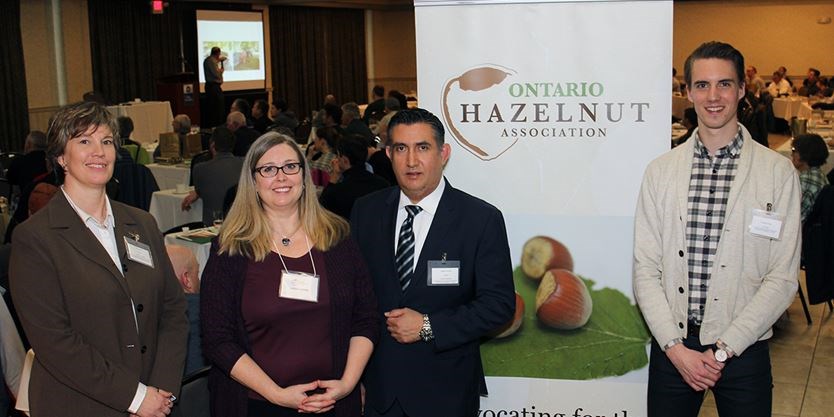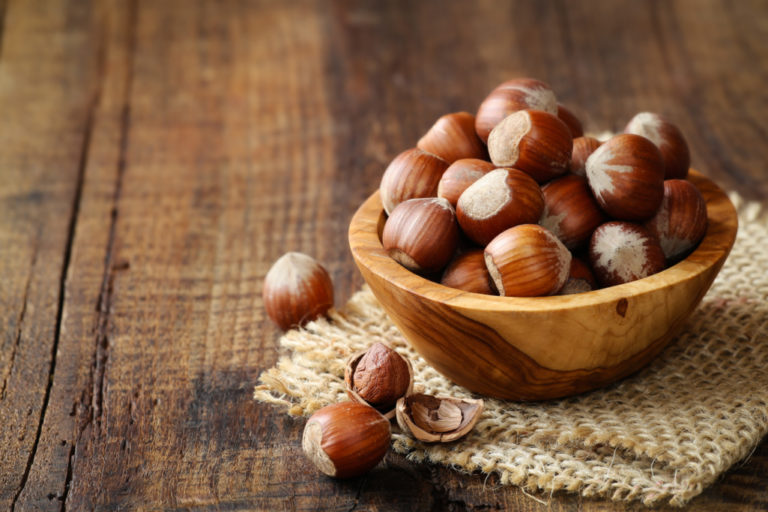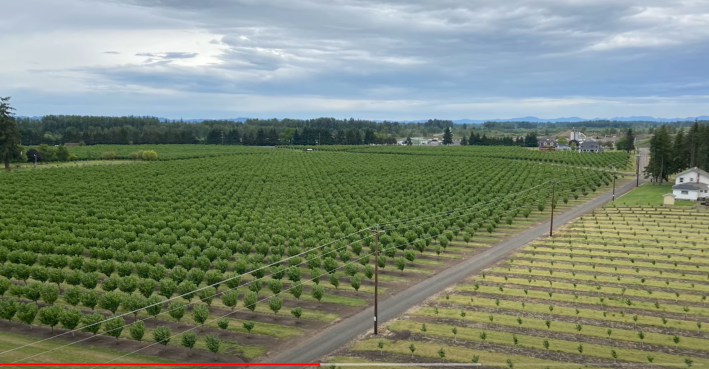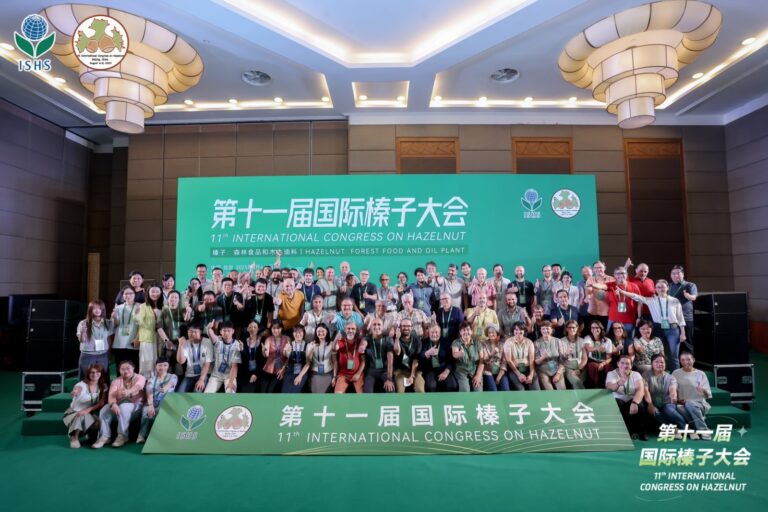Hazelnuts touted as Ontario cash crop
‘Suitability, profitability and sustainability’ key to growing industry

From left, Ferrero Rocher agronomist Barb Yates, Ontario Hazelnut Association president Linda Grimo, Ferrero Head of Global Agri-Development and Innovation Jorge Acevedo, and Ontario Hazelnut Association Project Manager Andrew Nixon in front of a full house at the 8th Annual OHA Symposium. – Jeff Tribe
‘Suitability, profitability and sustainability’ are the three key words for those considering hazelnuts as a cash crop, says Ferrero Rocher agronomist Barb Yates.
“It’s suitable to our climate, I believe hazelnuts can be more profitable in the long term, and in my opinion, there is a sustainability we can achieve with this crop.”
In a nutshell, that was Yates’ response to the million dollar question ‘why an Ontario farmer would consider moving in a bold new direction.’ And it was a question being cracked open among a record estimated 225 participants in the 8th Annual Hazelnut Symposium Tuesday, March 28 at Brantford’s Best Western Hotel and Conference Centre.
Part annual general meeting for the Ontario Hazelnut Association (OHA), part information session for current growers, the event is also an introduction to those considering a departure from familiar seasonal efforts including wheat, soybeans and corn into the long-term approach of nut farming. That conversation’s starting point lies just west of Brantford along the 403 in the massive Ferrero Rocher plant, considered by the company as one of its ‘larger’ of 22 (soon to be 23) worldwide, servicing Canada, United States, Mexico, Australia and New Zealand.
“The market is here,” said Yates. “There is an end user, we have capacity, we need to fill that capacity.”
Ferrero, which prefers shopping local where it can and supports the development effort, has forwarded the aggressive goal of ’23 by 23’: 23,000 acres of Ontario hazelnuts to be in production by 2023.
“Ideally, we’d like to get it all,” said Yates. “But if we can get even some of it, that would be tremendous for the farmers, the local economy and Ferrero, a triple win.”
Challenges include extreme weather events (Turkey, where 75 per cent of the world’s crop is currently grown does experience snow, but less severe cold) and Eastern Filbert Blight (EFB) which can prove devastating to nonresistant trees. Ontario farmers’ recommended options are currently Yamhill, Jefferson and Gama, varieties developed in Oregon for its climatic conditions, along with local pollinators Gene and Slate (Grimo Nurseries), Norfolk and Chelsea (Martin Hodgson, Butternut Farms, Courtland).
It takes years to develop a nut variety from inception to mass production, says Linda Grimo, OHA president and daughter of Ernie Grimo of Grimo Nurseries. The three Oregon varieties are ‘great for today,’ she continued, but preferably, a locally-bred product reflecting this province’s conditions will eventually arrive. The ideal Ontario variety will be cold hardy, EFB resistant, productive and annual bearing.
“It’s asking a lot, but we can do it.”
Incentive lies in the fact Ferrero imports 14,000 tons of hazelnuts annually for its Brantford plant, and has doubled its worldwide demand every decade. Ontario’s nut-growing community is growing at what she calls a ‘manageable pace’, but still represents just the tip of the iceberg of its ultimate potential.
“We are on the forefront of something really wonderful.”
Ferrero’s tangible commitments to the endeavour include a MOU signed with the OHA in 2013, renewed and extended at this year’s symposium, along with Yates’ hiring as a full-time agronomist. There are challenges to growing hazelnuts in Canada, agrees Ferrero Head of Global Agri-Development and Innovation Jorge Acevedo, but so too are there potential rewards.
Acevedo listed upsides including Canada’s strong and modern agricultural infrastructure, political stability, access to technology and finance and positioning adjacent to the U.S., its single largest market in the world.
“The benefits outweigh the challenges I would say 90 to 10, definitely.”
“The potential is here for sure,” agreed Ferrero Agri-Innovation Agronomist Eloy Suarez Huerta, who like Acevedo, is based out of Luxembourg. “The challenge is to find the right varieties for our needs.”
In a lesser-developed environment, Ferrero may establish a model farm said Acevedo, but in a technologically-strong area such as Ontario, the company prefers to let local expertise establish which varieties and practices are best.
At that point, Yates’ position will change to project manager as Ferrero provides full support to develop a Canadian outgrowing program that provides know-how, technological support and long-term contracts through a network of third-party producers that works in an agreed way to cultivate, produce and process hazelnuts.
“It’s a profitable business,” he summed up, listing diversification and higher profitability as advantages for producers. “And it will trickle down to the general economies of the province.”
OHA Project Manager Andrew Nixon estimates there will be 500 acres planted in Ontario by spring, 2018. A mature hazelnut orchard has 135 trees per acre, in practice typically double-planted and every-other tree subsequently transplanted for higher profitability in the long run. Trees currently cost around $15 per, begin to produce in their third or fourth year, and are considered mature between eight and 10 years of age. Beyond the trees, other inputs include soil testing and modification along with possibly, some form of irrigation. Orchards have a lifespan of between 60 and 100 years and at maturity, modelling suggests individual trees will produce 4.5 kilograms of nuts annually or 2,000 pounds per acre, which at the current market price of $1.51 per pound, represents a $3,000 annual gross.
Interest in hazelnut production continues to grow, says Nixon, who has seen the symposium double in size since 2015.
“I think this is us only getting started,” he said.
This year’s event was buoyed by the announcement of $600,000 in new funding from Ontario’s Centre of Excellence for suitability mapping and to increase the availability of tree stock.
And while momentum continues to build, Nixon said the current focus for the 2017 symposium is capitalizing on that through laying out steps in a plan identifying progress toward association goals.
“We’ve been building momentum, building momentum, now we need to translate that into action. What we are talking about today is what that action looks like in the next couple of years.”
Copyright: norfolknews.ca






